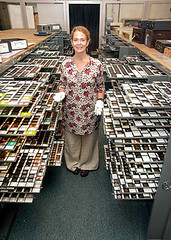
PREV ARTICLE
NEXT ARTICLE
FULL ISSUE
PREV FULL ISSUE
SMITHSONIAN CURATOR KAREN LEE VISITS SRI LANKAKaren Lee of the National Numismatic Collection at the Smithsonian recently visited Sri Lanka, where she met longtime E-Sylum contributor Kavan Ratnatunga. Kavan writes: Ms Karen Lee's one week visit to Sri Lanka was very useful for the Numismatic community in Colombo. Members of the Sri Lanka Numismatic Society met up with her for Lunch on Monday 22nd. She did a 3 day workshop on Museum Studies from 23 to 25th at the Colombo National Museum which included a Public Lecture on 24th on "The Power of Museums" of which a Transcript is posted at http://www.archaeology.lk/public-lecture/the-power-of-museums/ and a session on "Research Methods and managements of Numismatic collections" on the 25th. She went on a 2 day trip to Kandy and Sigiriya. Her interview appears in the Sunday Times Karen adds: The collectors all brought coins to show me---ancient to modern---it was wonderful…the time I spent with that group was instructive, inspiring and really fun!
Here's an excerpt from the Sunday Times article. Be sure to read the complete version online.
-Editor
“Museums around the world are struggling with why they matter within society,” Karen says. “Everybody feels like the internet has definitely levelled the playing field.” Museums can no longer lay claim to being the solitary storehouses of knowledge and information is abundant (even if some of it is inaccurate). “If that’s not what museums are good for, what are we good for in the 21st century?” she asks. “It’s about taking a hard look at what we do and who we do it for.” In Colombo last week at the behest of the American Centre, she delivered a lecture on ‘The Power of Curating: Making Museums Come Alive’. Karen ties her talk into her theme of re-examining her approach as a curator – “It’s about involving different communities, people whose voices don’t necessarily feel like they previously belonged.” There is also another reason Karen would have laughed if someone had told her where she’d end up – she didn’t have the slightest interest in numismatics or the study of coins and currency until she walked into that Smithsonian’s Numismatic Department 10 years ago. She was called in to help manage a crisis. The institution’s decision to ‘mothball’ a celebrated coin exhibit had sparked public uproar. Her mandate was to do a little triage work, find some funds and get a small exhibit opened again.
Having graduated with a degree in biology, with a Masters in Museum Science tacked on later, Karen is largely self-taught. “Actually, I like to tell women and girls this about myself,” she says, explaining that she uses her personal journey to illustrate how simply embracing curiosity can lead you in unexpected and wonderful directions. Karen is keenly aware of how female numismatists are a rare breed in the U.S. She says thinking about how to display, interpret and position the Smithsonian’s many numismatic objects so that they resonate better with women is a focus for her personally. Karen has worked at the Smithsonian for close on 30 years (she actually started out as a research assistant in the botany department). Working in the world’s biggest museum complex is simply “awesome”, says Karen. She counts herself particularly lucky, that the objects of her fascination – some 1.5 million numismatic treasures – are all stored in a vault in the same building. As lucky as she counts herself to be working at the Smithsonian, she says expecting everyone who wants to see these historical riches to visit the museum is both “impractical” and “not collaborative.” Its why, despite being initially sceptical about the public’s interest, she created the Smithsonian travelling coin programme. As part of it, the Smithsonian agreed to take one of their most prized coins on a tour of seven European cities. Though 500,000 of these gold coins were originally minted, only 13 ‘Double Eagles’ survive today. The historical value of these 13 were multiplied exponentially when the rest were melted down to help to stabilise the American economy by removing gold from circulation during the Great Depression. Accompanying the coin, Karen was astounded when the final tally came in – an estimated 10 million people had encountered the exhibit in some form, whether through the many media events like the BBC talk show or directly, in person. People standing for hours in a queue in Prague gently corrected her when she asked why they were so interested in American history – it was a piece of world history they had come to see, they said.
To read the complete article, see:
Making museums come alive
(www.sundaytimes.lk/130728/plus/making-museums-come-alive-54415.html)
The Numismatic Bibliomania Society is a non-profit organization promoting numismatic literature. See our web site at coinbooks.org. To submit items for publication in The E-Sylum, write to the Editor at this address: whomren@gmail.com To subscribe go to: https://my.binhost.com/lists/listinfo/esylum All Rights Reserved. NBS Home Page Contact the NBS webmaster 
|
